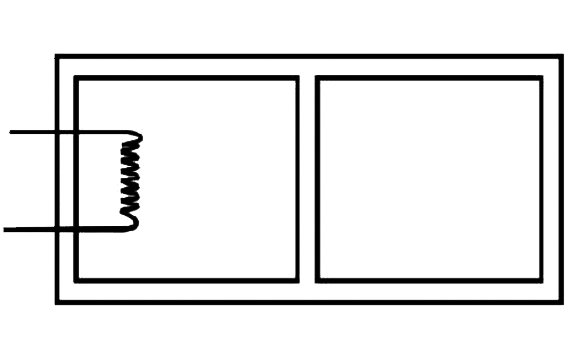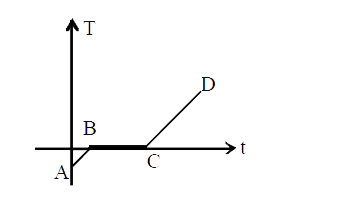A certain amount of ice is supplied heat at a constant rate for 7 min. For the first one minute the temperature rises uniformly with time. Then it remains constant for the next 4 min and again the temperature rises at uniform rate for the last 2 min. Given .
The initial temperature of ice isSolution in Gujrati
The correct Answer is:D
Let heat is supplied at a rate of then
Therefore initial temperature =
Final temperature =
Topper's Solved these Questions
- BOOK - ALLEN CHAPTER - GEOMETRICAL OPTICSEXERCISE - EXERCISE - 04 (A)48videos
GEOMETRICAL OPTICS
- BOOK - ALLEN CHAPTER - GEOMETRICAL OPTICSEXERCISE - EXERCISE - 04 (B)15videos
GEOMETRICAL OPTICS
- BOOK - ALLEN CHAPTER - GEOMETRICAL OPTICSEXERCISE - ASSERTION-REASON40videos
GEOMETRICAL OPTICS
- BOOK - ALLEN CHAPTER - CURRENT ELECTRICITYEXERCISE - EX.II66videos
CURRENT ELECTRICITY
- BOOK - ALLEN CHAPTER - GRAVITATIONEXERCISE - EXERCISE 49videos
GRAVITATION
Similar Questions
Two rods each of length L2 and coefficient of linear expansion α2 each are connected freely to a third rod of length L1 and coefficient of expansion α1 to form an isoscles triangle. The arrangement is supported on a knife-edge at the midpoint of L1 which is horizontal. what relation must exist between L1 and L2 so that the apex of the isoscles triangle is to remain at a constant height from the knife edge as the temperature changes ?
06:27View SolutionThe rectangular box shown in Fig has partition which can slide without friction along the length of the box. Initially each of the two chambers of the box has one mole of a mono-atomic ideal gas (λ=5/3) at a pressure P0, volume V0 and temperature T0. The chamber on the left is slowly heated by an electric heater. The walls of the box and the lead wires of the heater is negligible. The gas in the left chamber expands pushing the partition until the final pressure in both chambers becomes 243P0/32. Determine (i) the final temperature of the gas in each chamber and (ii) the work done by the gas in the right chamber.
 03:58View Solution
03:58View SolutionStatement-1: A real gas behaves as an ideal gas at high temperature and low pressure .
Statement-2: Liquid state of an ideal gas is impossible.08:12View SolutionIn the Bohr's model of hy drogen atom, the electron moves around the nucleus in a circular orbit of radius 5×10−11m. Its time period is 1.5×10−16s. The current associated with the electron motion is:-
04:24View SolutionAssertion : The difference in the value of acceleration due to gravity at pole and equator is proportional to square of angular velocity of earth.
Reason : the value of acceleration due to gravity is minimum at the equator and maximum at the pole.04:24View SolutionIn the above problem if heat is supplied at a constant rate of q= 10 cal//min , then plot temperature versus time graph.
03:14View SolutionA certain amount of ice is supplied heat at a constant rate for 7 minutes. For the first one minute the temperature rises uniformly with time. Then, it remains constant for the next 4 minute and again the temperature rises at uniform rate for the last two minutes. Calculate the final temperature at the end of seven minutes. (Given, L of ice = 336 xx (10^3) J//kg and specific heat of water = 4200 J//kg-K ).
07:58View SolutionCalculate the amount of heat required to convert 10 g ice at -10^@C into steam at 120^@C at normal pressure. If heat is supplied uniformly at the rate 50cal//s , sketch variation temperature with time
03:22View SolutionA certain amount of ice is supplied heat at a constant rate for 7 min. For the first one minute the temperature rises uniformly with time. Then it remains constant for the next 4 min and again the temperature rises at uniform rate for the last 2 min. Given Sice=0.5cal/g∘C,Lf=80cal/g.
The initial temperature of ice is05:39View SolutionA certain amount of ice is supplied heat at a constant rate for 7 min. For the first one minute the temperature rises uniformly with time. Then it remains constant for the next 4 min and again the temperature rises at uniform rate for the last 2 min. Given S_("ice")=0.5cal//g^(@)C,L_(f)=80cal//g . Final temperature at the end of 7 min is
02:17View SolutionWhat amount of ice at -14^(@)C required to cool 200gg of water from 25^(@)C to 10CC? (Given C_("ice")=0.5cal/g.^(@)C,L_(f) for ice =80cal//g )
04:58View SolutionThe temperature of a body rises by 44^(@)C when a certain amount of heat is given to it . The same heat when supplied to 22 g of ice at -8^(@)C , raises its temperature by 16^(@)C . The water eqivalent of the body is [Given : s_(water) = 1"cal"//g^(@)C & L_(t) = 80 "cal" //g, s_("ice") = 0.5"cal"//g^(@)C ]
07:24View SolutionHeat is being supplied at a constant rate to a sphere of ice which is melting at the rate of 0.1 gm/sec. It melts completely in 100 sec. The rate of rise of temperature thereafter will be (Assume no loss of heat)
04:53View SolutionHeat is supplied to a ice at a constant rate Temperature variation with time is as shown in figure. Then –
 04:03View Solution
04:03View SolutionHeat is being supplied at a constant rate to a sphere of ice which is melting at the rate of 0.1 gm/sec. It melts completely in 100 sec. The rate of rise of temperature thereafter will be (Assume no loss of heat)
04:08View SolutionIn any pond water 10 cm There is thick ice Seen next 1 mm Thick ice 49 min 9 s It takes time The thermal conductivity of ice 0.005 CGS unit , Melting heat of ice melting = 80 cal / g and density 0.917 g / cm^3 If the outside air temperature?
View Solution

